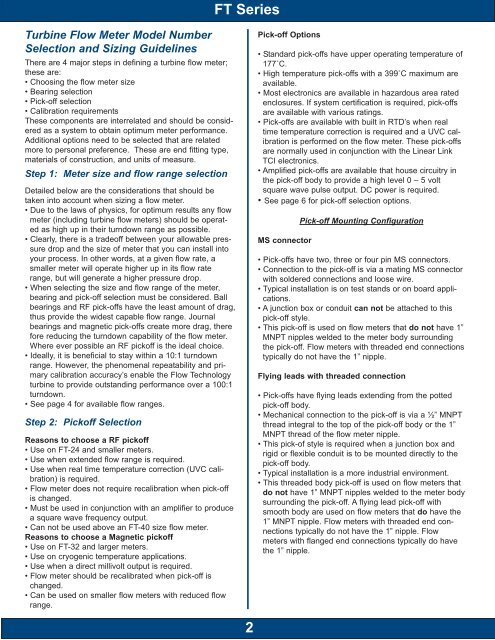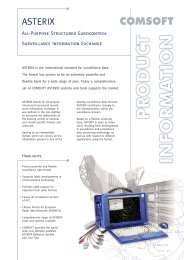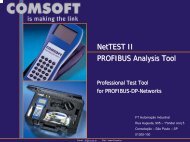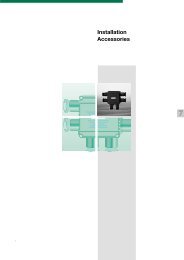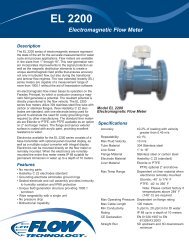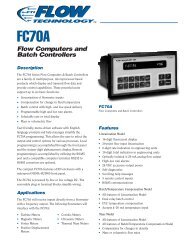Flow Technology FT Series Turbine Flowmeters for Liquid Applications
Flow Technology FT Series Turbine Flowmeters for Liquid Applications
Flow Technology FT Series Turbine Flowmeters for Liquid Applications
Create successful ePaper yourself
Turn your PDF publications into a flip-book with our unique Google optimized e-Paper software.
<strong>FT</strong> <strong>Series</strong><br />
<strong>Turbine</strong> <strong>Flow</strong> Meter Model Number<br />
Selection and Sizing Guidelines<br />
There are 4 major steps in defining a turbine flow meter;<br />
these are:<br />
• Choosing the flow meter size<br />
• Bearing selection<br />
• Pick-off selection<br />
• Calibration requirements<br />
These components are interrelated and should be considered<br />
as a system to obtain optimum meter per<strong>for</strong>mance.<br />
Additional options need to be selected that are related<br />
more to personal preference. These are end fitting type,<br />
materials of construction, and units of measure.<br />
Step 1: Meter size and flow range selection<br />
Detailed below are the considerations that should be<br />
taken into account when sizing a flow meter.<br />
• Due to the laws of physics, <strong>for</strong> optimum results any flow<br />
meter (including turbine flow meters) should be operated<br />
as high up in their turndown range as possible.<br />
• Clearly, there is a tradeoff between your allowable pressure<br />
drop and the size of meter that you can install into<br />
your process. In other words, at a given flow rate, a<br />
smaller meter will operate higher up in its flow rate<br />
range, but will generate a higher pressure drop.<br />
• When selecting the size and flow range of the meter,<br />
bearing and pick-off selection must be considered. Ball<br />
bearings and RF pick-offs have the least amount of drag,<br />
thus provide the widest capable flow range. Journal<br />
bearings and magnetic pick-offs create more drag, there<br />
<strong>for</strong>e reducing the turndown capability of the flow meter.<br />
Where ever possible an RF pickoff is the ideal choice.<br />
• Ideally, it is beneficial to stay within a 10:1 turndown<br />
range. However, the phenomenal repeatability and primary<br />
calibration accuracy’s enable the <strong>Flow</strong> <strong>Technology</strong><br />
turbine to provide outstanding per<strong>for</strong>mance over a 100:1<br />
turndown.<br />
• See page 4 <strong>for</strong> available flow ranges.<br />
Step 2: Pickoff Selection<br />
Reasons to choose a RF pickoff<br />
• Use on <strong>FT</strong>-24 and smaller meters.<br />
• Use when extended flow range is required.<br />
• Use when real time temperature correction (UVC calibration)<br />
is required.<br />
• <strong>Flow</strong> meter does not require recalibration when pick-off<br />
is changed.<br />
• Must be used in conjunction with an amplifier to produce<br />
a square wave frequency output.<br />
• Can not be used above an <strong>FT</strong>-40 size flow meter.<br />
Reasons to choose a Magnetic pickoff<br />
• Use on <strong>FT</strong>-32 and larger meters.<br />
• Use on cryogenic temperature applications.<br />
• Use when a direct millivolt output is required.<br />
• <strong>Flow</strong> meter should be recalibrated when pick-off is<br />
changed.<br />
• Can be used on smaller flow meters with reduced flow<br />
range.<br />
2<br />
Pick-off Options<br />
• Standard pick-offs have upper operating temperature of<br />
177˚C.<br />
• High temperature pick-offs with a 399˚C maximum are<br />
available.<br />
• Most electronics are available in hazardous area rated<br />
enclosures. If system certification is required, pick-offs<br />
are available with various ratings.<br />
• Pick-offs are available with built in RTD’s when real<br />
time temperature correction is required and a UVC calibration<br />
is per<strong>for</strong>med on the flow meter. These pick-offs<br />
are normally used in conjunction with the Linear Link<br />
TCI electronics.<br />
• Amplified pick-offs are available that house circuitry in<br />
the pick-off body to provide a high level 0 – 5 volt<br />
square wave pulse output. DC power is required.<br />
• See page 6 <strong>for</strong> pick-off selection options.<br />
MS connector<br />
Pick-off Mounting Configuration<br />
• Pick-offs have two, three or four pin MS connectors.<br />
• Connection to the pick-off is via a mating MS connector<br />
with soldered connections and loose wire.<br />
• Typical installation is on test stands or on board applications.<br />
• A junction box or conduit can not be attached to this<br />
pick-off style.<br />
• This pick-off is used on flow meters that do not have 1”<br />
MNPT nipples welded to the meter body surrounding<br />
the pick-off. <strong>Flow</strong> meters with threaded end connections<br />
typically do not have the 1” nipple.<br />
Flying leads with threaded connection<br />
• Pick-offs have flying leads extending from the potted<br />
pick-off body.<br />
• Mechanical connection to the pick-off is via a ½” MNPT<br />
thread integral to the top of the pick-off body or the 1”<br />
MNPT thread of the flow meter nipple.<br />
• This pick-of style is required when a junction box and<br />
rigid or flexible conduit is to be mounted directly to the<br />
pick-off body.<br />
• Typical installation is a more industrial environment.<br />
• This threaded body pick-off is used on flow meters that<br />
do not have 1” MNPT nipples welded to the meter body<br />
surrounding the pick-off. A flying lead pick-off with<br />
smooth body are used on flow meters that do have the<br />
1” MNPT nipple. <strong>Flow</strong> meters with threaded end connections<br />
typically do not have the 1” nipple. <strong>Flow</strong><br />
meters with flanged end connections typically do have<br />
the 1” nipple.


